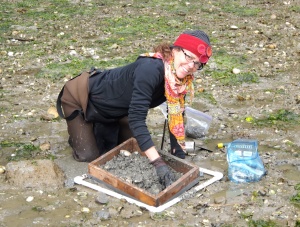#IamANaturalist
Blog post from the ESA BLOG
Are you a naturalist? Join the grassroots effort to reclaim the name. ESA’s Natural History section is calling on you to assert your naturalist identity with pride by tweeting a photo to #IAmANaturalist on Monday, September 8, 2014.
 I am a Naturalist — I use careful observations of the natural world to inform my daily life and research. My practice of natural history feeds my research program with questions, and answers.
I am a Naturalist — I use careful observations of the natural world to inform my daily life and research. My practice of natural history feeds my research program with questions, and answers.
But I don’t think I’ve ever introduced myself as a naturalist. When was the last time you heard an ecologist introduce herself as a NATURALIST? Why do we reject that identity? Isn’t natural history the seed of many ecological questions—and in some cases the answer?
This is why we (@esanathist ) are starting a #IAmANaturalist campaign to raise awareness about the prevalence of naturalists in ecology and the importance of natural history.
Without natural history knowledge, I would be lost. In my research I look for patterns in nature and I ask questions about what shapes those patterns.
In the absence of natural history information, our progress toward an understanding of complex ecological questions grinds to a halt. Impacts of climate change? Depends on the natural history. Management of threatened populations? The devil is in the details of how and where they live and die. Disease prevention? Same story. All of our sophisticated models are only as good as the natural history that informs them.
The field of Ecology is young, and it stands on the shoulders of natural history. Many of the icons in ecology, such as G.W. Carver, E. Leopold, E.O. Wilson, J. Goodall, J. Lubchenco, S. Earle, R. Kimmer, etc. were and are fundamentally naturalists, observing and recording the natural world in situ and in its entirety with a keen appreciation to connections and interactions. It is the first-hand experiences in nature that give us the ”Rachel Carlson / Gene Likens” insights that unlock mysteries and help solve major environmental solutions. It is also the naturalist instinct that is open to the abundance of complexity in ecosystems, which fuels our passion for better scholarship.
Yet most ecologists don’t teach natural history courses. Anecdotally, this seems especially true for junior faculty. Over the past decades we have seen a steady decline in the practice of natural history, perceived value of natural history, and natural history course work for biology majors (Tewksbury et al. 2014). These statistics beg the question, what will the field of ecology look like in a future without a strong emphasis on the training and retention of young naturalists?
We cannot afford to loose the skillset of natural history in ecology. We need to invest in and support more naturalists and more natural history institutions (museums, field stations, and botanical gardens)! The ecological issues that we will face in the future require more than ever the diverse insights of folks who can read landscapes, make careful field observations, recognize anomalies, accurately record patterns in nature, and make hypotheses that come from an education that only experience in observing nature can give you.
The Natural History Section of the Ecological Society of America invites you to join our #IamaNaturalist campaign. If you practice natural history, then reclaim the name “Naturalist” by posting a picture of yourself (i.e. in the field or with a specimen) with the hashtag #IamaNaturalist. Please give a shout out for the celebration of natural history, the oldest human endeavor and the forerunner to the field of ecology. If you prefer facebook over twitter, you can join this campaign by posting your #IamaNaturalist picture on our facebook page.
Our hope is to start a wildfire of support for the value of natural history and the people who spend their days (or nights) practicing natural history. We hope that this engagement starts some conversations around the importance of natural history in ecology and that it provokes a trend of closeted naturalists to proudly present their passion for natural history to the world!
“#IAmANaturalist. It’s only in the last year or so that I’ve become comfortable with using that title. More officially, I am an ecologist. Certainly these titles are not, and should not, be mutually exclusive…”
Read more: on his blog, naturalist (and ecologist) Nash Turley explains what natural history means to him, and why he strives to root more of his research in natural history observations.
Natural History’s Place in Science and Society (2014) Joshua j. Tewksbury, John G. T. Anderson, Jonathan D. Bakker, Timothy J. Billo, Peter W. Dunwiddie, Martha J. Groom, Stephanie E. Hampton, Steven G. Herman, Douglas J. Levey, Noelle J. Machnicki, Carlos Martínez del Rio, Mary E. Power, Kirsten Rowell, Anne K. Salomon, Liam Stacey, Stephen C. Trombulak and Terry A. Wheeler. BioScience, First published online: March 26, 2014. doi: 10.1093/biosci/biu032.
Kirsten Rowell is curator of malacology at the Burke Museum of Natural History in Seattle, Wash., and a biologist at the University of Washington, currently on sabbatical in Geneva, Switzerland. She uses sclerochronology, stable isotope ratios, and elements to tell her about the lives of fish and molluscs living thousands of years ago, comparing where they live, what they eat, and where they are in a trophic web to living animals — but it is her observational knowledge about these ecosystems that informs her interpretations of these tools.
